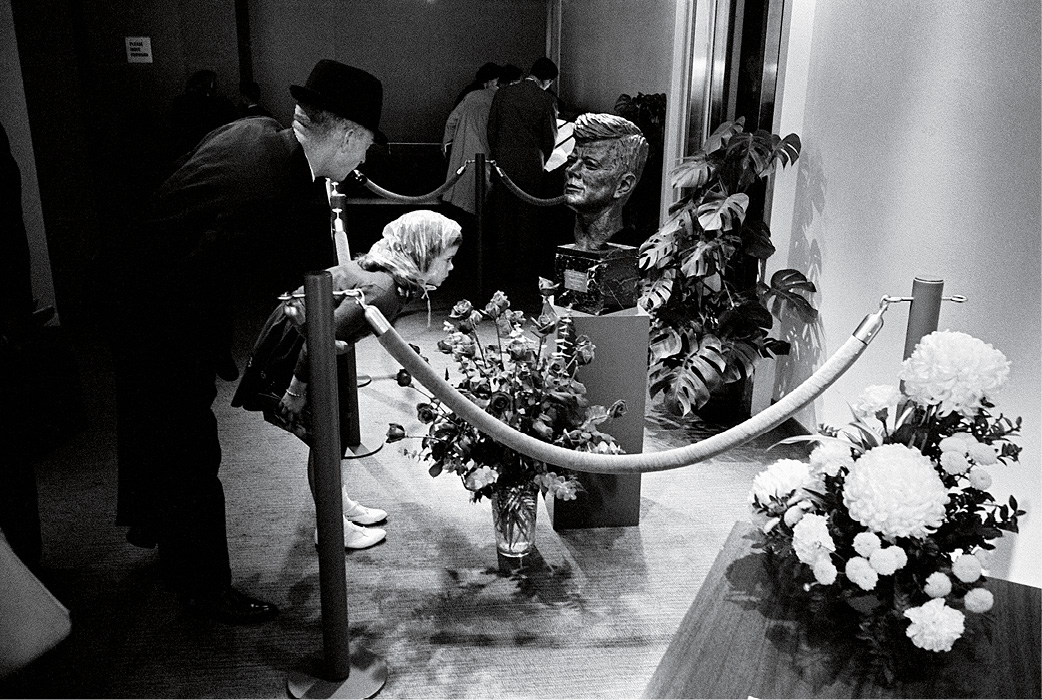
DENNIS STOCK/MAGNUM
Respects are paid during an exhibition remembering JFK at the IBM Building in New York in 1964.
The Kennedy Legacy
There is a phrase: “He lived on after his time.” Rarely has this been more applicable than to John F. Kennedy. He had already achieved much in his cut-short life, and it was almost as if everyone—his successor, his former colleagues, his brothers, his sisters, his children, his countrymen—felt duty-bound to honor his wishes and thereby his memory.
LEGACIES CAN BE MEASURED IN brick and mortar, in flesh and blood, in spirit and inspiration. The first equation is the easiest to quantify. There are dozens—scores, hundreds—of John F. Kennedy schools in the United States, including one in Montana and another on Long Island that were renamed the very week after his death. There are a dozen Kennedy schools in the Netherlands. There are airports and plazas around the world, and Kennedy streets in Lebanon and Israel. In France there are two dozen Kennedy avenues, boulevards and rues, plus at least one corniche and one cours.
He left a legacy of family: Jackie, Caroline and John Jr. went on in life, accomplishing much, each of them contributing. Jackie died too young, of cancer, and John died much too young in an airplane crash. More Kennedy tragedy. Caroline continues today as she always has: a beacon of intelligence and diligence, doing the family—and the nation—proud. Her kids, a son and two daughters, are strong young adults now.
We know what happened to Jack’s brothers, of course, and it would be impossible in this space to delineate, even briefly, what happened to all of their various offspring. If these myriad personal histories of the newest generation needed a solid bookend, it has one now in Joe Kennedy III, who in 2012 won his race for Massachusetts’s 4th district congressional seat. And so, after a very brief hiatus, a Kennedy is back in Washington. Who knows how many more might be forthcoming?
Who knows, indeed, what might be next for this family, or what might still be accomplished in America and throughout the world thanks to the words that John F. Kennedy spoke, and the initiatives he undertook, more than a half century ago? There are still young people (and older) in the Peace Corps today, doing good works globally. The cold war did end, eventually, without any kind of general annihilation; the Soviet Union came apart, and Kennedy surely contributed to that. The Johnson administration had tremendous successes with civil rights initiatives, always pushing them forth by insisting that this is what JFK wanted. All of its other Great Society policies—the most progressive social agenda fulfilled since the New Deal—was pushed in the spirit of Kennedy. Those policies have their detractors today (and so does Kennedy and so does Johnson). But when we’re discussing legacies, we’re discussing results: the actual, the tangible—an influence felt all the way to the present day. And Kennedy left all manner of legacy.
Presidents who came after, men of both parties, have said they were inspired by him. Awards, which are based upon achievements that in turn are based upon words and actions, have been given out to the next generation’s best and brightest in his name. No President who lived such a short time in office has persevered so durably in his American afterlife.
It is a cliché to say that “society changed in the 1960s.” Within the cliché, we see fire hoses, hippies, Vietnam protests, riots. Society, however—and everything—had changed earlier than that, with Kennedy, the transitional figure: a hero of World War II, a member of the Greatest Generation, a man never seen in anything but a suit or, at Hyannis Port, a polo shirt. But new and different and young.
Fifty years after his death, we still yearn for his presence.

DENNIS STOCK/MAGNUM
Respects are paid during an exhibition remembering JFK at the IBM Building in New York in 1964.
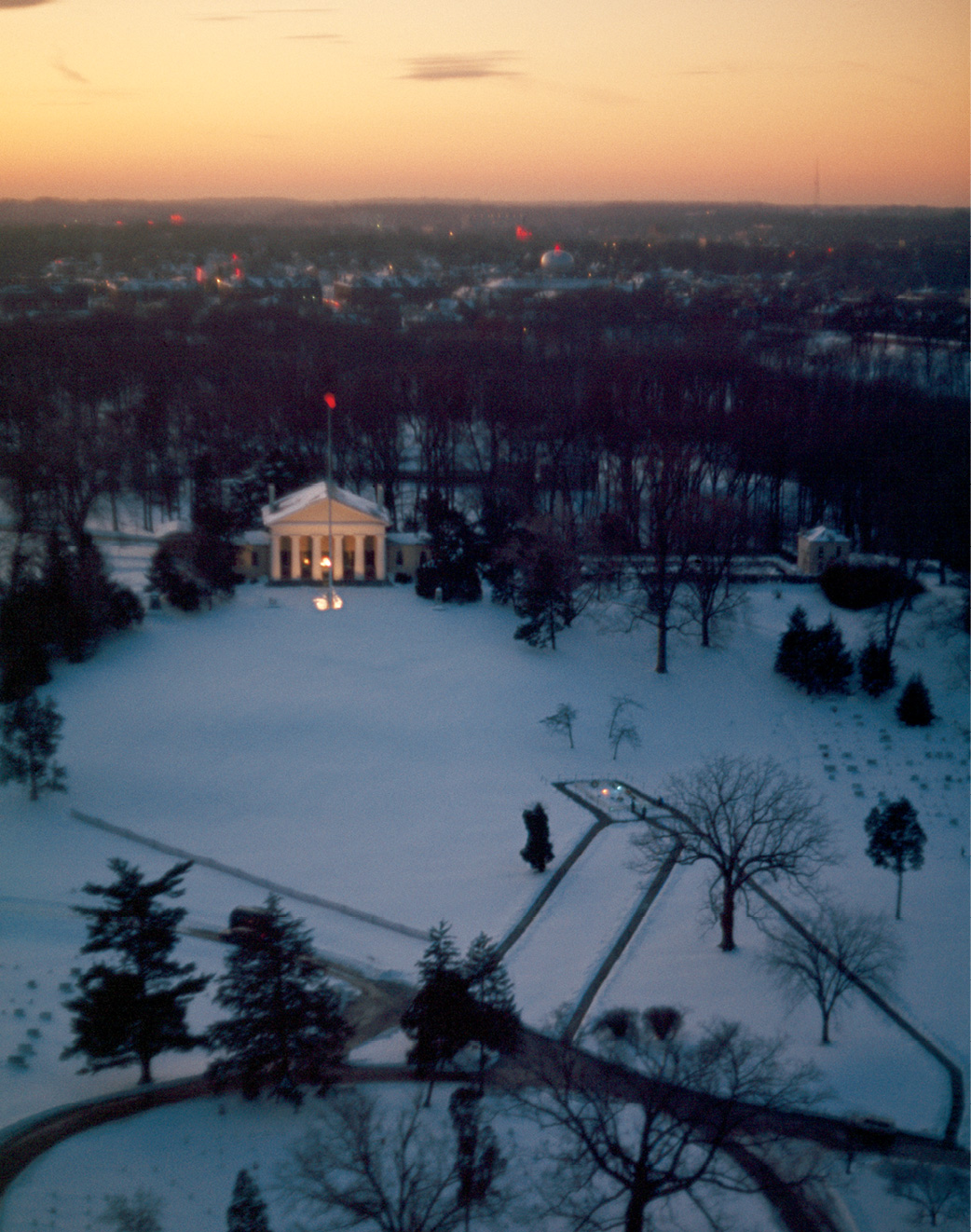
ROBERT F. SISSON/NATIONAL GEOGRAPHIC
After a surprise snowstorm in early September 2007, President Kennedy’s eternal flame (slightly right of center) takes on added serenity. The part of the Kennedy legacy that would be most consequential for millions of people would be the legislation that was enacted across the Potomac in Washington, during the tenure of his successor Lyndon Johnson. A master politician—and a master manipulator—Johnson accomplished things by leaning on perceived debts owed to Kennedy that JFK himself probably could not have pushed through. The greatest triumphs were the Civil Rights Act of 1964 and the Voting Rights Act of 1965. Mark Updegrove, Johnson biographer and director of the late Texan’s presidential library, says, “Kennedy couldn’t have gotten those done. Johnson could and did. He leveraged tragedy to get those crucial laws passed.”
The Widow
Jackie

GLOBE/ZUMA
If we look at über-famous American women of the 20th century, we find such as Eleanor Roosevelt and such as Grace Kelly, and then we have Jackie, indisputably an icon, a combination of both, singular. In the aftermath of the President’s death, no one assumed she was done—and she wasn’t. In the public realm she spearheaded cultural initiatives like the restoration of New York City’s Grand Central Terminal that reminded all of her work at the White House, and personally she found an edifying profession as a book editor. She was active in tributes to her late husband, be they the John F. Kennedy Presidential Library and Museum in Boston, the John F. Kennedy Center for the Performing Arts in Washington or others in between. Above, in 1967, she and John Jr. look on gleefully as Caroline christens the Naval aircraft carrier John F. Kennedy. By any estimation, Jackie was a fine and hands-on parent, the proof being the solid young adults her two children became.
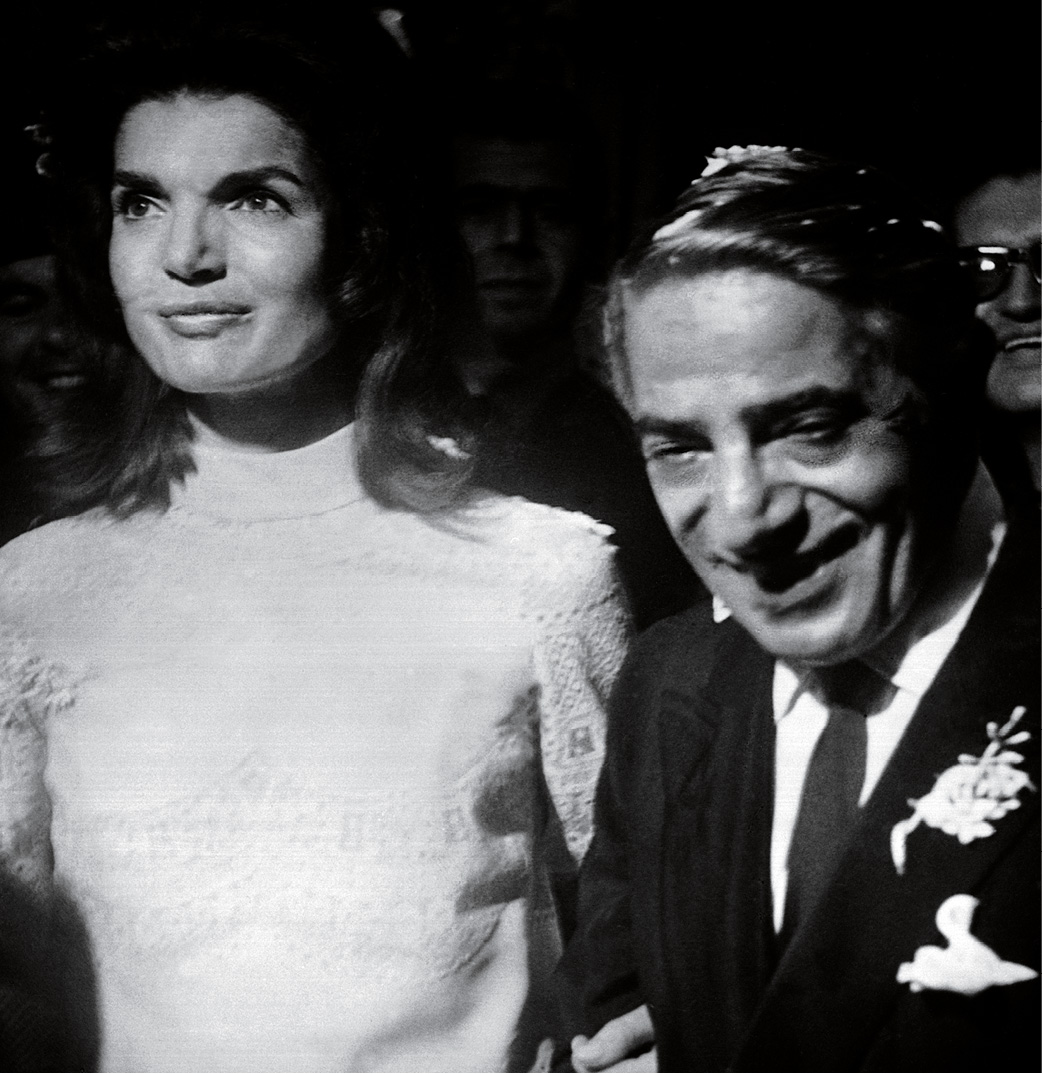
HELLAS/CAMERA PRESS/REDUX
Jackie asked for privacy, a request not granted; in a contest without a winner, she was probably the world’s greatest celebrity. She had told LIFE’s Theodore H. White that she had no intention to leave America and raise her children elsewhere, and she did not in fact leave, making New York City home. But she did marry Aristotle Onassis, the phenomenally wealthy Greek shipping magnate (seen above, on their wedding day, October 20, 1968, on the Greek island of Skorpios). Jackie overnight became Jackie O in the tabloids and magazines, and if she had thought or hoped this second marriage might distance her somewhat from the spotlight, it served no such purpose.
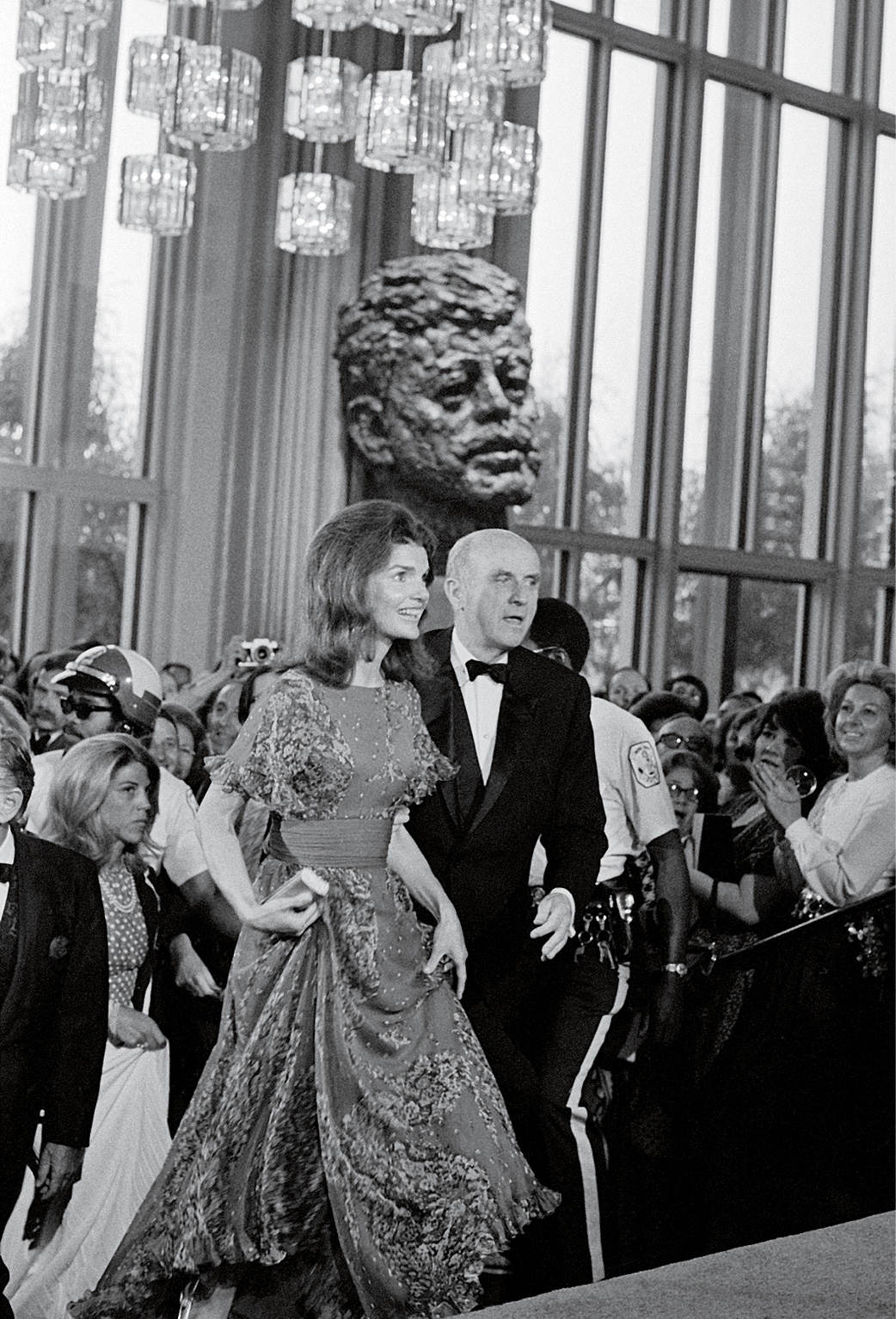
BETTMANN/CORBIS
Jackie is escorted by Roger Stevens, then chairman of the board of the Kennedy Center for the Arts, to a 1971 performance of Leonard Bernstein’s Mass, a work dedicated to her late husband.

GARY HERSHORN/REUTERS
Jackie was diagnosed with non-Hodgkin’s lymphoma in early 1994 and the end was relatively quick; she died in her sleep on May 19, 1994, and the next day John Jr. issued a statement: “My mother died surrounded by her friends and her family and her books, and the people and the things that she loved. She did it in her own way, and on her own terms, and we all feel lucky for that.” In the photgraph above, John touches the gravestone of his father at Arlington National Cemetery on May 23 as his mother’s casket sits beside the eternal flame during burial services.
The Next Brother
Bobby
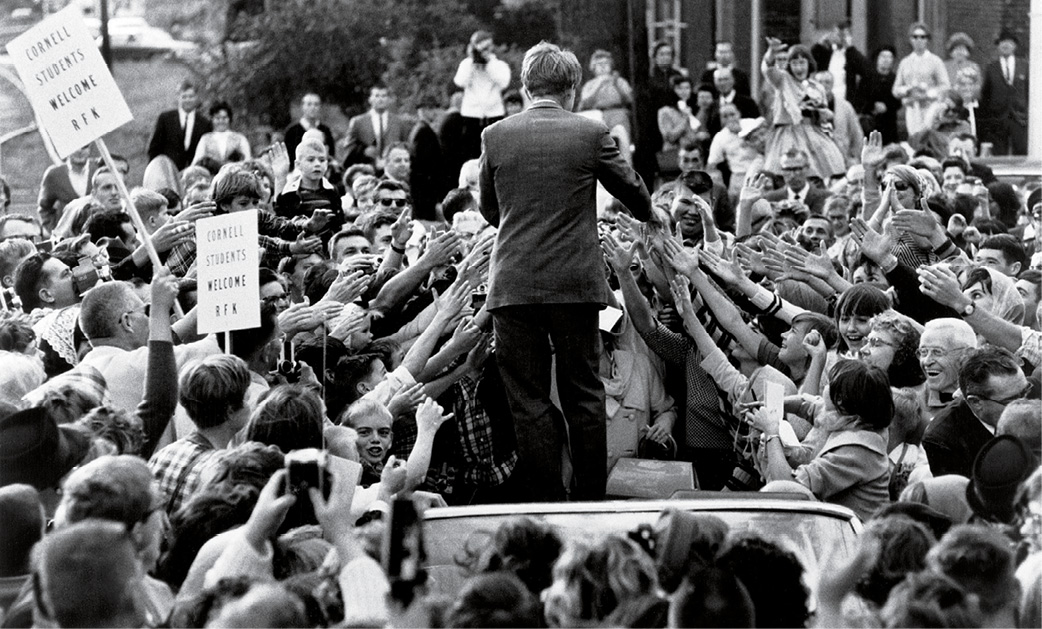
BILL EPPRIDGE
With Jack’s generation of Kennedys, each of those who were left—his widow, his brothers and sisters—had to eventually think: What is next for me? What part of the legacy is bequeathed? Do I go my own way? Do I follow Jack’s path? For Bobby, certainly, the question was: Do I pick up the torch? He was the next brother in line. When Joe Jr. had been killed, Jack had carried on. Would Bobby do—or attempt to do—the same?
He did, in his way. He ran for the Senate from New York and won, overcoming charges of carpetbagging, charges that are part of the game in New York (see: everyone from James L. Buckley to Hillary Clinton). His appeal to the young was stunning; the term “rock star” wasn’t on the table when Jack had been President, but now it was, and Bobby was a rock star, just as his brother had been (Above: Outshining the New York congressional candidate for whom he is campaigning in November 1966).
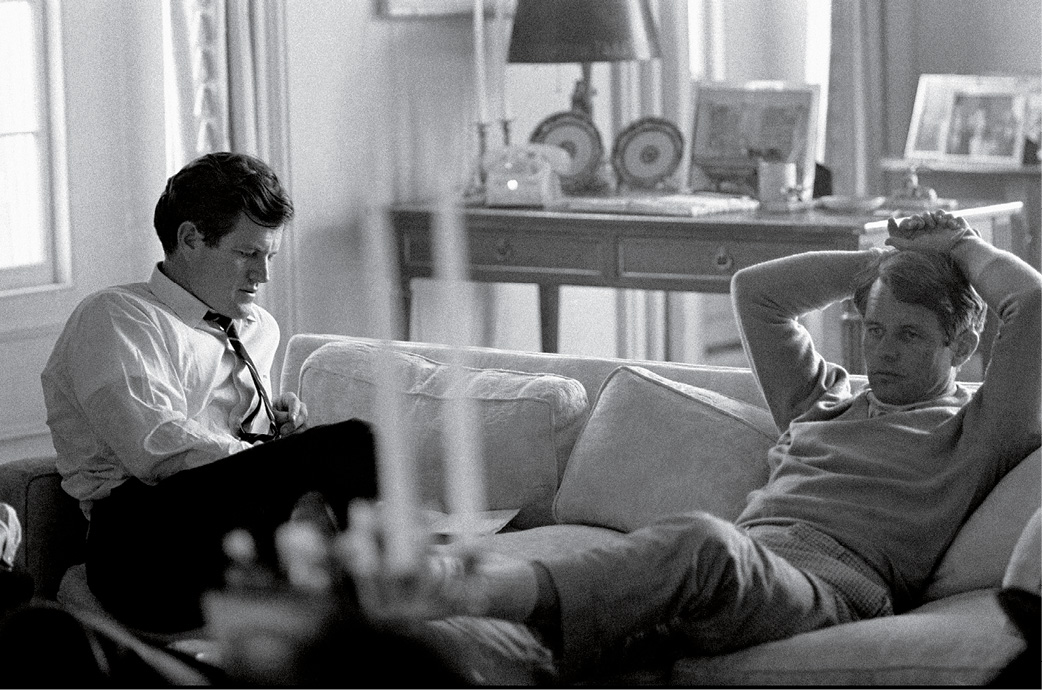
BURT GLINN/MAGNUM
The big question as 1968 approached and Lyndon Baines Johnson was increasingly engulfed by a progressively unpopular war in Vietnam: Would Bobby run for President? Would he challenge Jack’s former Vice President, whom Bobby, in particular, had always detested?
He seemed reluctant, but LBJ was discouraged early by the New Hampshire primary results, and announced that he would not run again. Bobby did enter the race and his campaign started to steamroll, fueled by a youthful energy.
Above: With brother Ted during a campaign strategy session at Bobby’s house, the storied Hickory Hill, in Virginia.
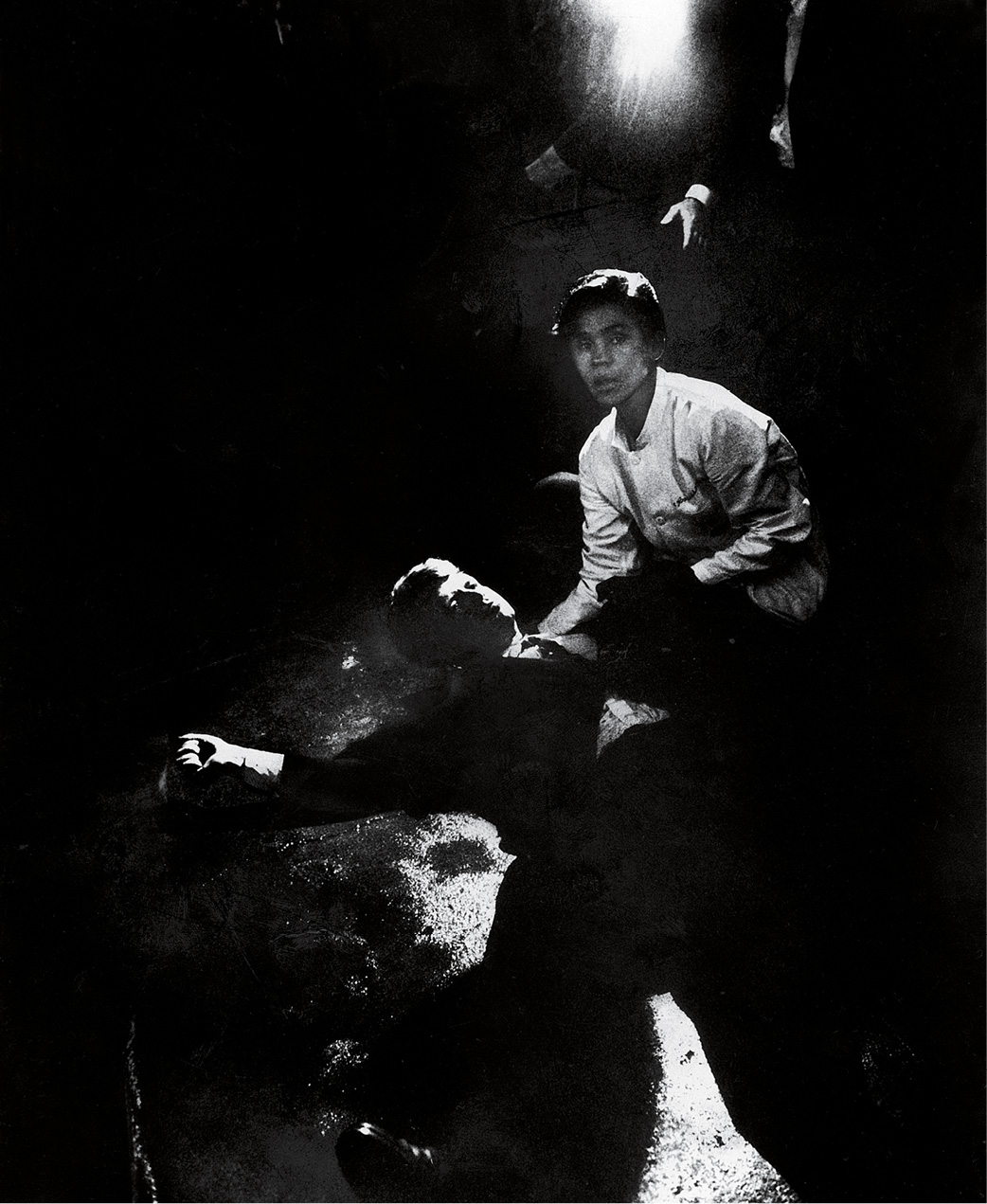
BILL EPPRIDGE
Bobby was in the midst of his greatest-yet victory in the California primary on June 5, a win that would surely catapult him to a general election showdown with none other than Richard Nixon, when he was assassinated at the Ambassador Hotel in Los Angeles by Sirhan Sirhan. In the famous photograph, taken that night by LIFE’s Bill Eppridge, who had been with the campaign from the start, the busboy Juan Romero cradles the stricken senator’s head.
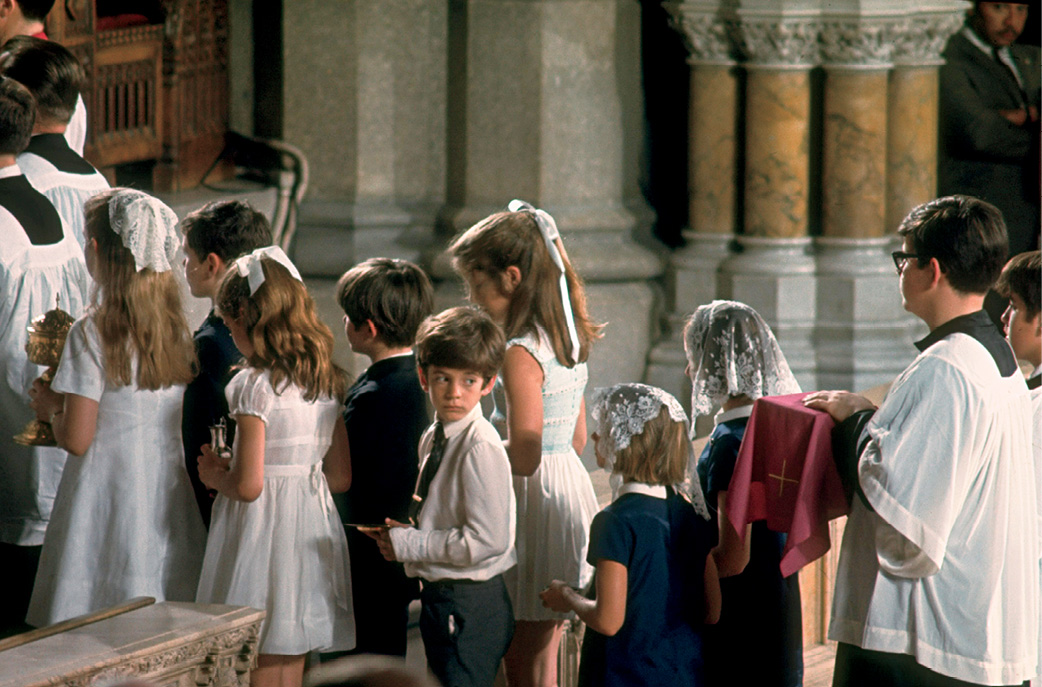
BOB GOMEL
Two days later, during funeral services at St. Patrick’s Cathedral in New York City, John F. Kennedy Jr. is seen turning as he walks next to his sister, Caroline. They are in the midst of a sea of Kennedy cousins (Bobby and Ethel already have 10 children and Rory is, at this time, on the way).
Now, by 1968, the idea is becoming part of the culture: that from this extraordinary American family, to which so much had been granted, much is being exacted.
The Youngest Brother
Teddy
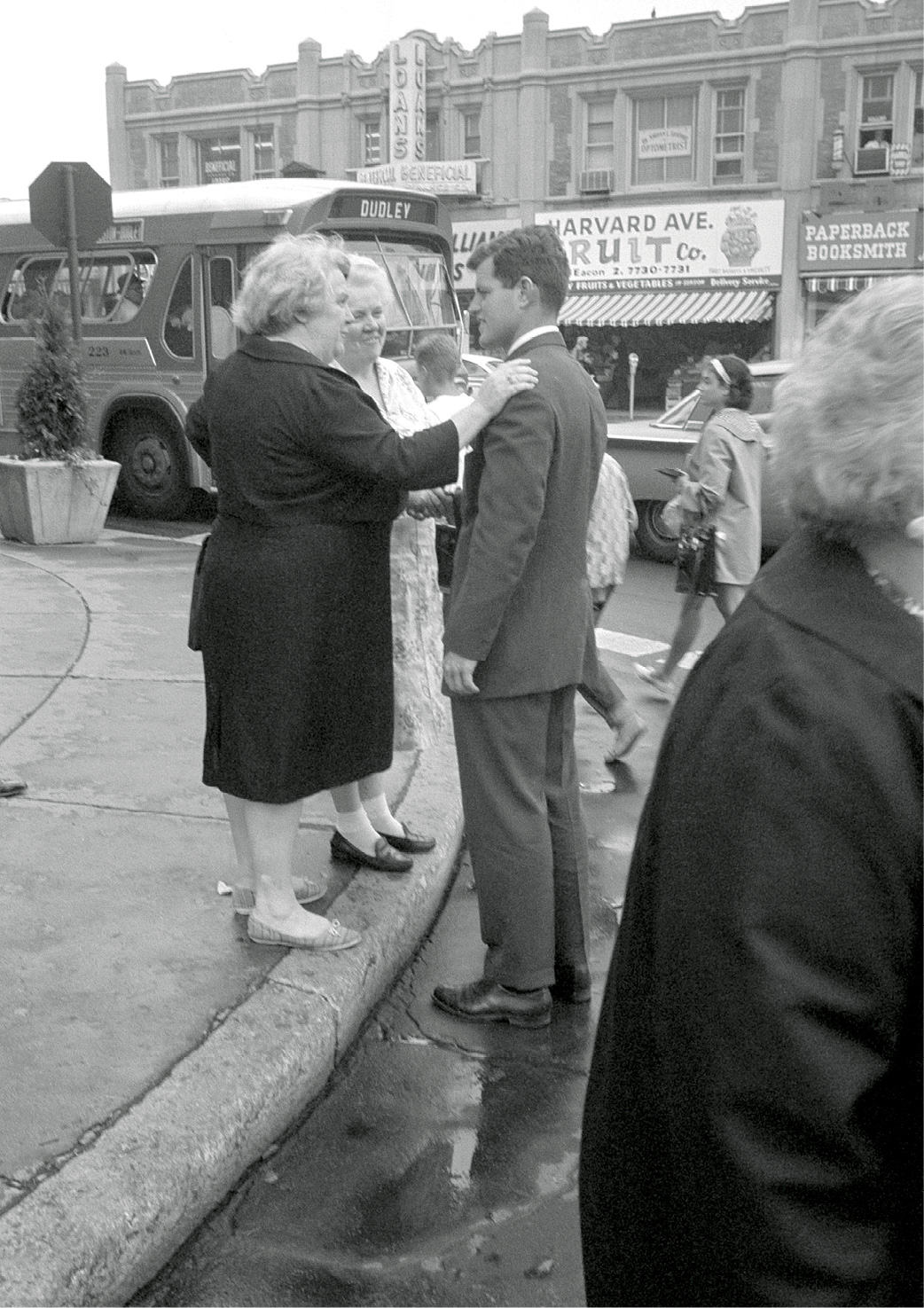
GEORGE TAMES/THE NEW YORK TIMES/REDUX
He certainly was to the manner born, and when Ted was tapped by the family to run for the Senate seat vacated by his brother Jack upon being elected President, he did as instructed—just as soon as he was legally able at age 30. Dick Donahue has told us already in these pages about the feuding within the Massachusetts Democratic party between the McCormacks and the Kennedys, and this was renewed in 1962 when the experienced war veteran Eddie McCormack vied for the seat with peach-faced Teddy Kennedy and quickly brought the race down to good old-fashioned bare-knuckles Massachusetts standards: “I back Jack, but Teddy ain’t ready,” said McCormack, and “The office of United States senator should be merited, and not inherited.” He declared snidely during a debate, that if his opponent’s name was Edward Moore instead of Edward Moore Kennedy, his candidacy “would be a joke.” Yes, but his name was Edward Moore Kennedy, and he defeated McCormack two-to-one in the primary, which was a de facto election (he brushed aside the Republican surnamed Lodge in the general contest). Ted Kennedy proceeded on a nearly 47-year career in the U.S. Senate (fourth-longest ever), with many legislative triumphs and exemplary bridge-building across the aisles, certainly one of the most distinguished congressional careers in U.S. history.
Above: Campaigning at Coolidge Corner in Brookline in August 1962.
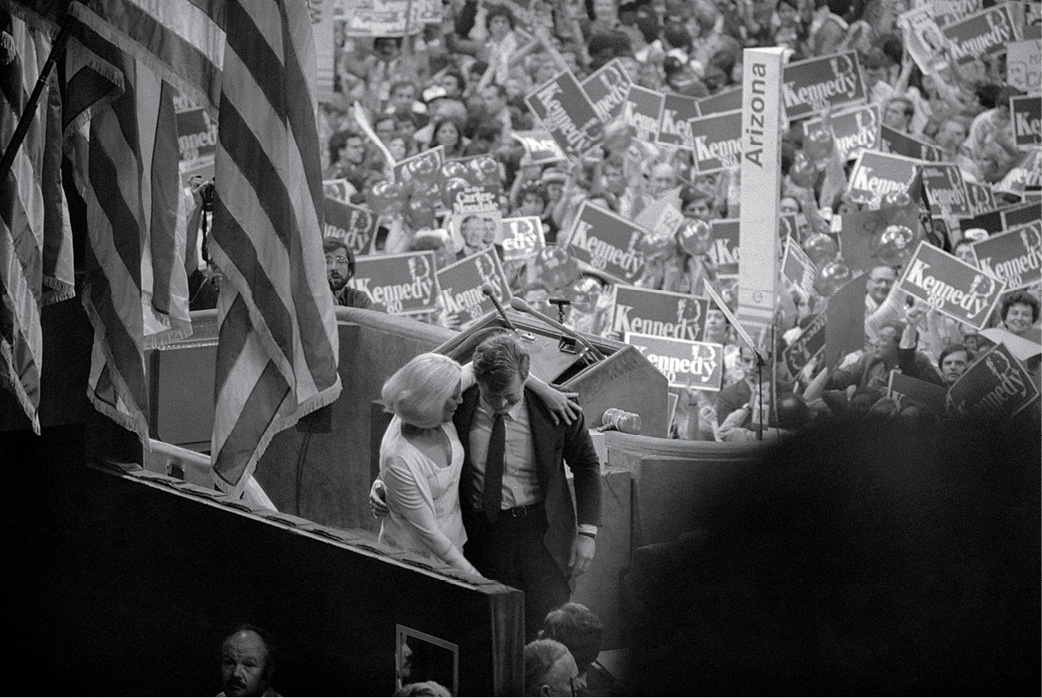
DARRYL HEIKES/BETTMANN/CORBIS
Teddy might have been President (above, with his first wife, Joan, at the 1980 Democratic convention in New York City, when he had failed in his attempt to unseat Jimmy Carter but had nonetheless delivered one of the most stirring speeches of his life). Yes, he might well have been President, but there had been an incident in July 1969: After a party to thank his brother Bobby’s former staff on the island of Chappaquiddick off Martha’s Vineyard, Kennedy drove off the Dike Bridge. He survived, but his passenger, Mary Jo Kopechne, drowned inside the overturned car.
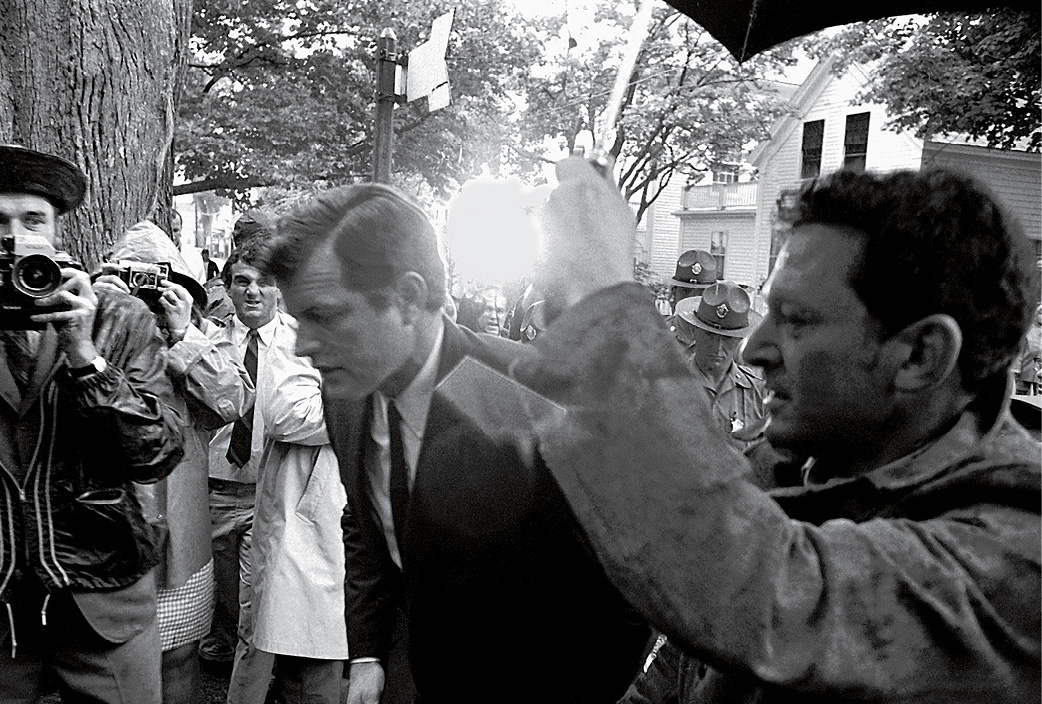
JOHN LANDERS/BOSTON HERALD/POLARIS
Kennedy gave a statement saying he had accidentally taken a wrong turn (above, he appears at Edgartown District Court on Martha’s Vineyard to plead “not guilty” to motor vehicle violations) and received a suspended sentence—which was not suspended the least bit in the court of public opinion.

KEN REGAN/CAMERA 5
With Jack and Bobby—not to mention both Joe Sr. and Joe Jr.—gone, Ted assumed the role not only of the last Kennedy lion in Washington, but of the family patriarch, which took some growing into. His nephew William Smith had legal trouble in Florida, and it turned out his patron at the Au Bar in Palm Beach earlier in the evening had been Uncle Ted. (Smith was acquitted of rape.) But Ted did right his ship (a metaphor he, an inveterate recreational sailor, would have appreciated), and with his second wife, Victoria Reggie, enjoyed a celebrated twilight. He would be the one to preside at weddings and wakes in these years (he would eulogize John Jr. when he died in 1999). And he became an ever better father (above: In Moscow, at the Kremlin—of all places!—in 1974, with his son Edward Jr., who has lost a leg to cancer; Teddy Jr.’s farewell remarks to his dad at the Boston funeral in 2009 were as eloquent and memorable as his father’s had been for John Jr.).
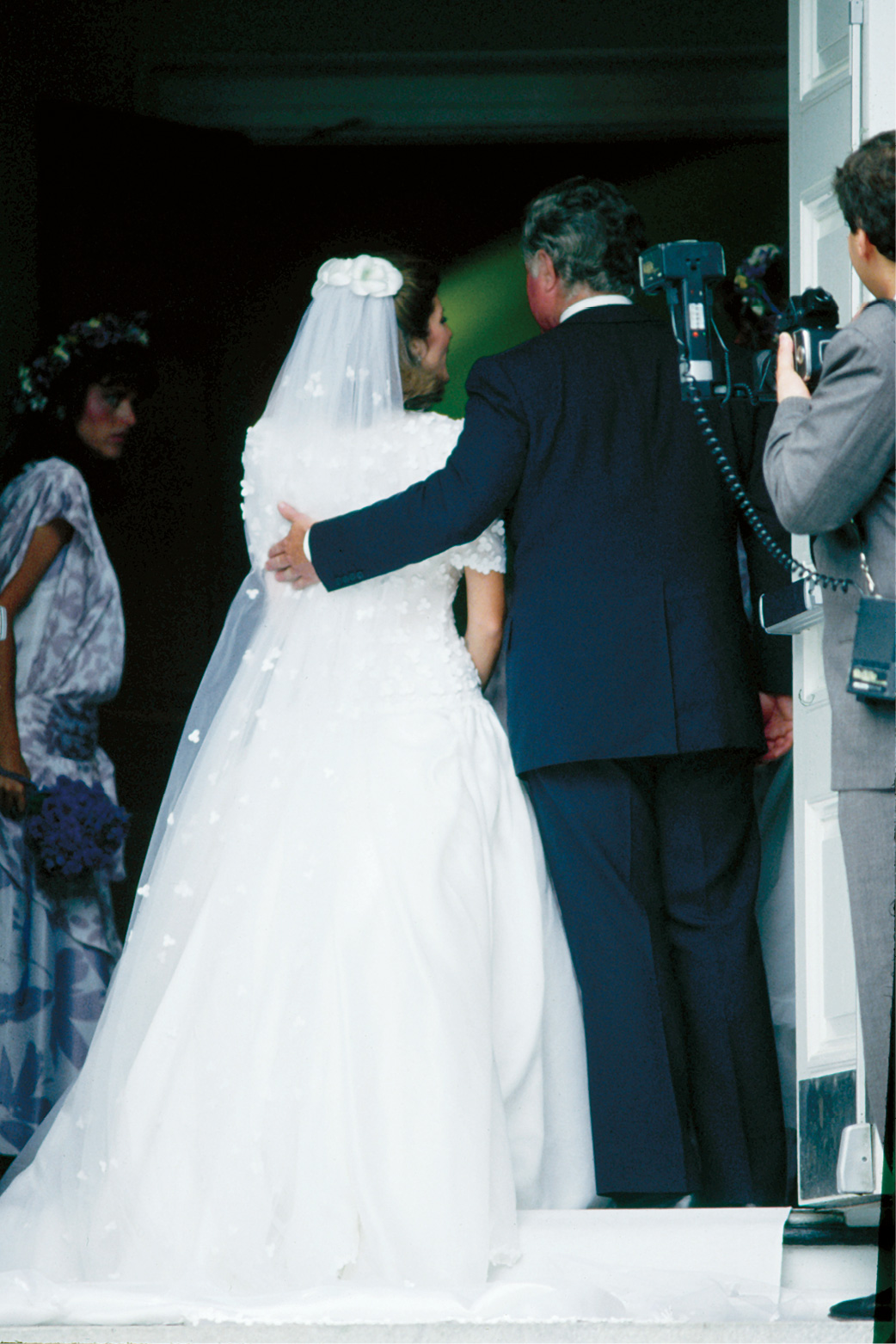
STEVE LISS
Teddy and Caroline make their entrance into the church on her wedding day, July 19, 1986.
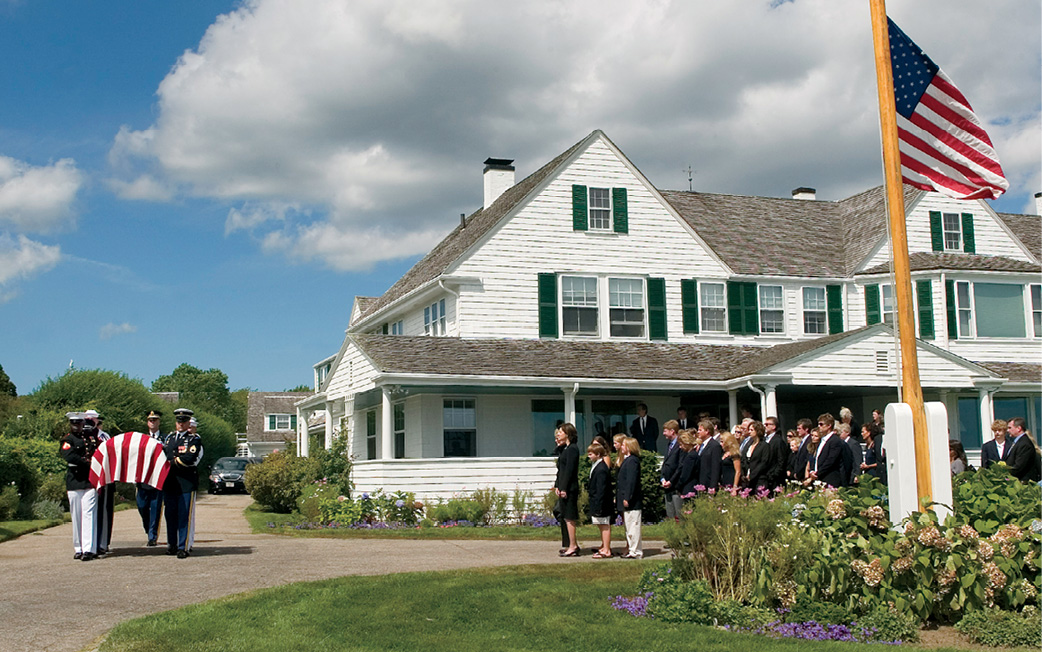
STEW MILNE/AP
Edward M. Kennedy’s casket is carried by an honor guard to a hearse at the Kennedy compound in Hyannis Port on August 27, 2009, after he has died at home at age 77 after a yearlong struggle with brain cancer.
The Daughter
Caroline

HARRY BENSON
After the pop anthem “Sweet Caroline” enjoyed a second life as the unofficial theme song of the Boston Red Sox during their very successful run in the new millennium, the singer and songwriter Neil Diamond disclosed that indeed, back in the ’60s, he had written the jaunty tune in honor of the late President’s daughter. Everyone was delighted by the disclosure, because no one has ever thought ill of Caroline—a rare circumstance with a Kennedy. And why would anyone? She was, from the very first time we met her when she was a child, bright, engaging and pointed in all the right directions. You might even say that she, too, could have been President, but that really wasn’t the case; when she floated her trial balloon for Hillary Clinton’s vacated U.S. Senate seat in December 2008, it very quickly popped. She didn’t have that Kennedy thing for politics. But she had everything else, and now, at 55 years old, she—a lawyer and a writer and editor like her mother, a keeper of the flame—is among the most admired of Americans.
Above: On the day she weds Edwin Schlossberg on July 19, 1986, at Our Lady of Victory Church in Centerville, Massachusetts, in a picture made for LIFE by Harry Benson.
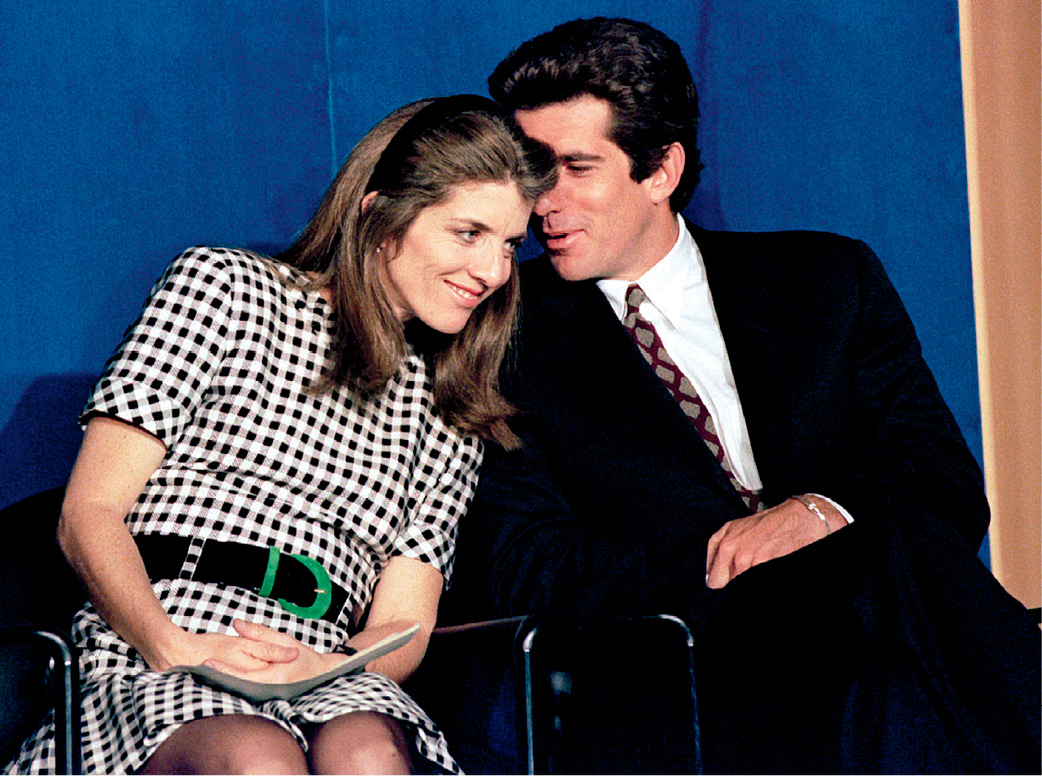
BRIAN SNYDER/REUTERS
With her brother during the Profile in Courage Award ceremony at the Kennedy Library in 1995.
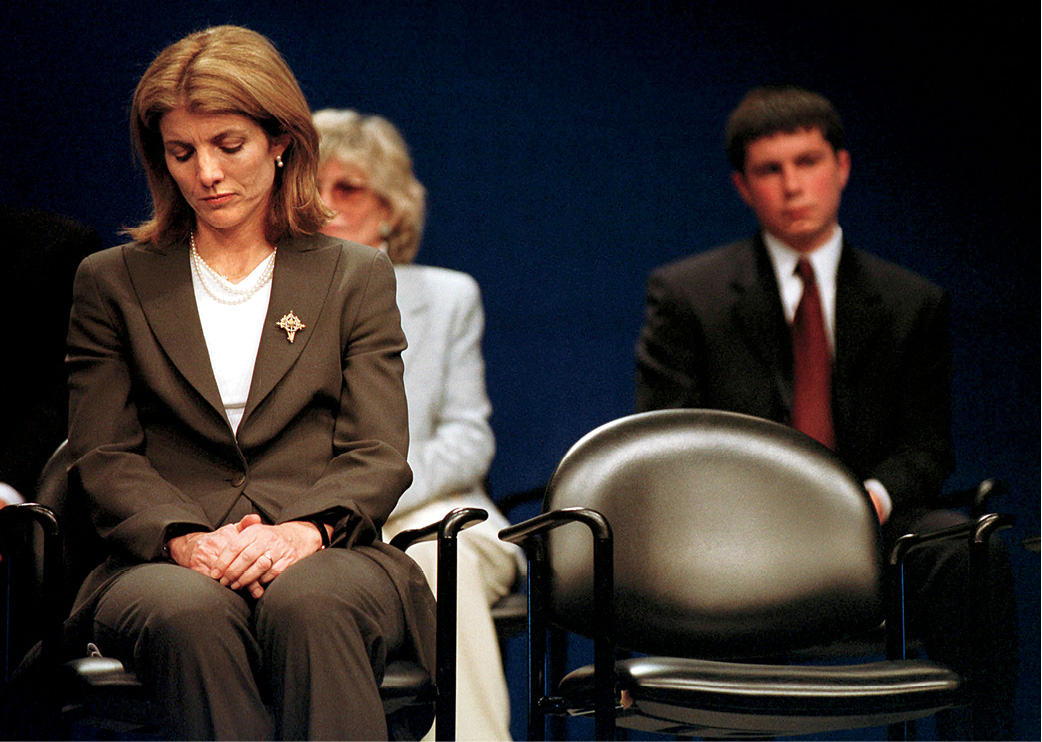
BRIAN SNYDER/CAMERA PRESS/REDUX
At the Profile in Courage Award ceremony in 2000, with her brother’s seat empty for the first time, as he, who had attended all of these awards programs since their inception, has died.
The Son
John Jr.

ARTHUR GRACE/ZUMA
He was the baby born into the White House, and as John-John (not ever his nickname when a child, and one he didn’t love later), he became America’s favorite kid, not least because his father happily—and to Jackie’s dismay—welcomed the press in to photograph his cute little boy and girl. After President Kennedy was killed, his widow proceeded differently, shielding her children as best she could from the glare. Since John and Caroline were the most famous of all the multitudinous Kennedy kids, we did know what was going on with them—which schools, what drama productions, what ski vacations—but we didn’t know much else. We were able to figure that they were not falling prey to the difficulties (drugs and such) faced by some of Bobby’s children, and so we felt well for them. When nice photos did circulate, like the one above of John and Caroline at the dedication of the Kennedy Library in Boston in 1977, we smiled.
John graduated from Brown University in 1983 and later got his law degree from New York University; he served as a prosecutor in the Manhattan district attorney’s office for four years. He could not help but become a public figure. Was he even more handsome than his father, or the uncle he never knew, Joe Jr.? Perhaps; quite possibly. In the judgment of the modern age, he was People magazine’s Sexiest Man Alive in 1988.

BRIAN SNYDER/REUTERS
Because Jackie kept the kids under wraps, the public thirsted for any news or pictures of them. One of John Jr. in the attitude that he made a signature in the 1990s is above, hat on backward, but it was made in a reflective moment: His grandmother Rose Fitzgerald Kennedy, matriarch of the family, has died the day before—January 22, 1995—at the compound in Hyannis Port. To counterbalance all these premature Kennedy deaths we are dealing with in these pages, we are happy to note that Rose was 104 years old.

MARK CARDWELL/REUTERS
That same year, 1995, John presides at the launch of his new political magazine, George, in New York City. It is an audacious effort and, for a time, an exciting and lively journal. It will not pan out for the long haul, but it gets everyone thinking again: Where is this Kennedy headed? Could he be headed for...?

TYLER MALLORY/LIAISON/GETTY
Meanwhile, John is taken off the “available” list when he weds Carolyn Bessette on September 21, 1996. Above, John gives her a kiss on the cheek during the annual White House Correspondents’ dinner in Washington in May 1999. Two months later—on July 16—John, who has a proper license, will choose to pilot a small plane from New Jersey to Martha’s Vineyard, on their way to his cousin Rory’s wedding on the Cape; he, his wife and one of Carolyn’s two sisters, Lauren, will be killed when the plane disappears into the Atlantic. John is 38.
Many of the Kennedy deaths have been tragic and certainly all of them have been sad. This might be the saddest.
The Future
Kennedys Compounded
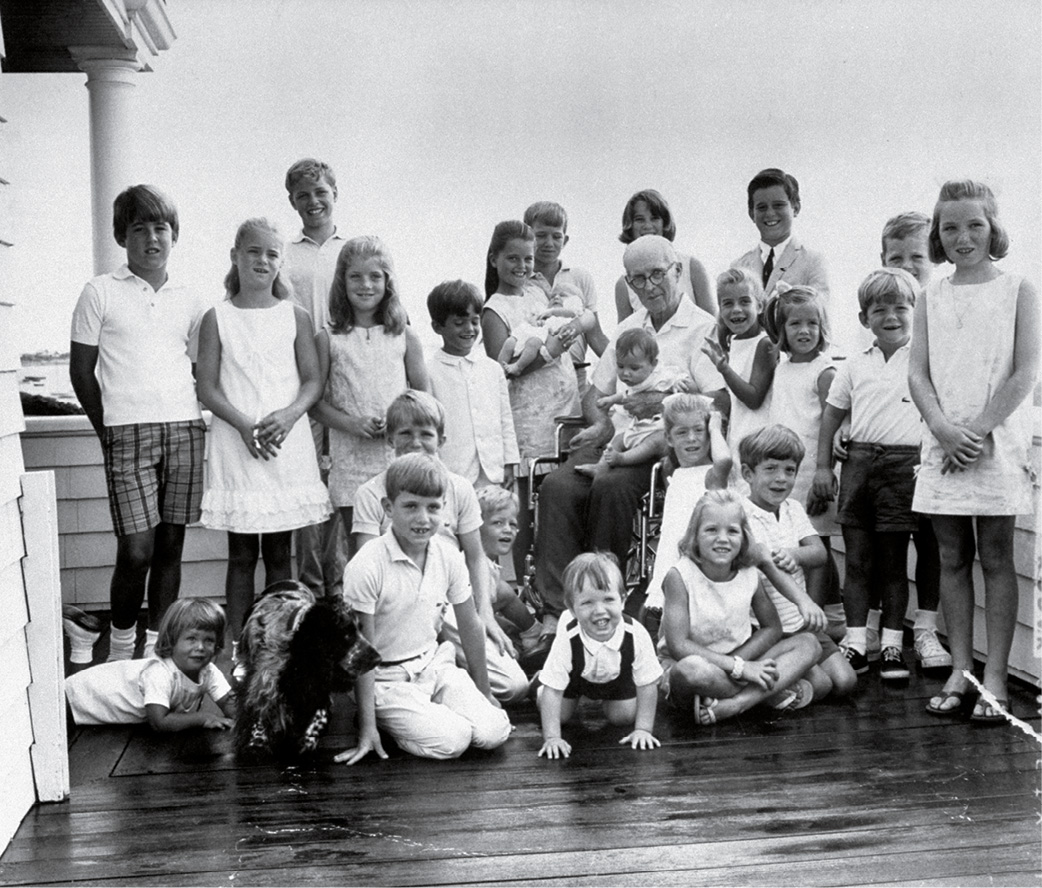
COURTESY KENNEDY FAMILY ALBUM
With the Kennedys it can be said: It’s always about family, it’s often about politics, it’s all about the past and it’s all about future—it’s all about the last generation, the current generation and the next one. It’s all about heritage and, again, family.
People who touch so many eras of this extraordinary saga are seen in the photograph above, made in 1965 in Hyannis Port, in which the ailing Joe Kennedy Sr. poses with his grandchildren—the offspring of Jack, Eunice, Patricia, Bobby, Jean and Teddy, the Greatest Generation. These children’s own children are now growing up, and some of them have made or will soon make the decision as to whether they should enter the family business. After Ted Kennedy died and then his son, Rhode Island congressman Patrick Kennedy, decided not to run for reelection to the House of Representatives in 2010, much was made of the fact that, for the first time in half a century, there was not a Kennedy in Washington.
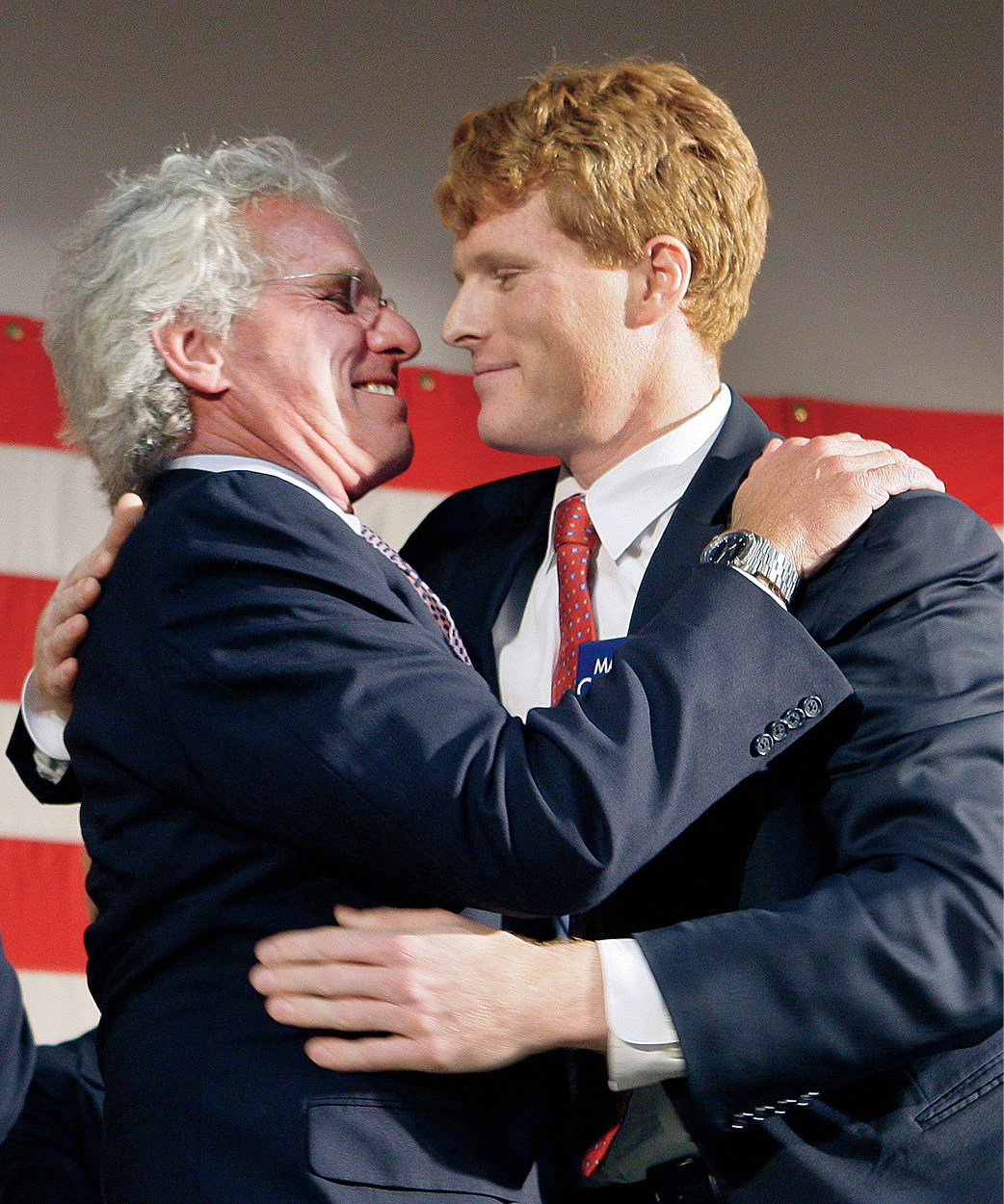
ELISE AMENDOLA/AP
But now there is again. Joseph P. Kennedy III, whose father, Joseph P. Kennedy II, has also spent time in the House, won election in 2012 to represent Massachusetts’s 4th district. (He is seen above getting a hug from Dad.) Joe is a grandson of Bobby and Ethel Kennedy.
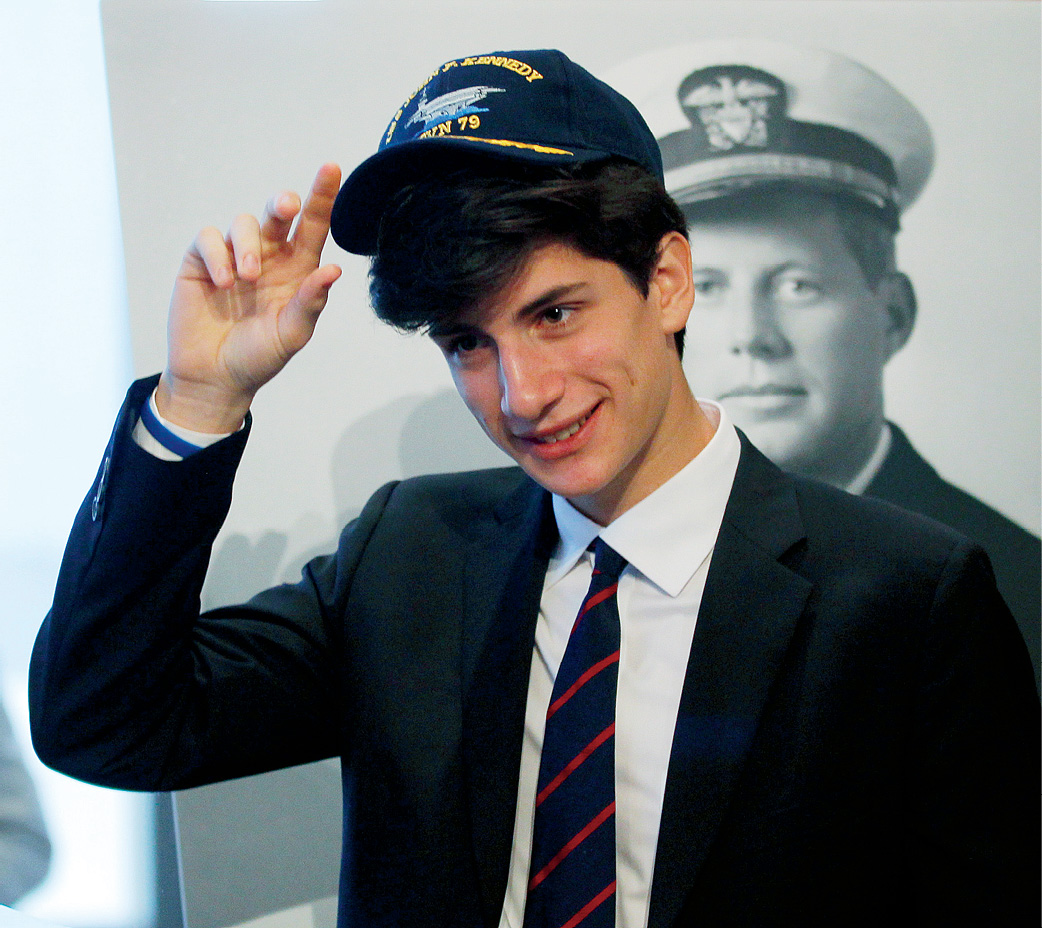
BRIAN SNYDER/REUTERS
Jack and Jackie, were they alive today, would have three grandchildren—Caroline’s daughters, Rose and Tatiana, and her son, Jack. Jack is seen in the photograph above at the Kennedy Library in Boston in May 2011, doffing a USS John F. Kennedy aircraft carrier cap in front of a picture of patrol boat skipper John F. Kennedy. It is worth noting that young Jack, Tatiana and Rose are all smart kids—and so is Joe III. They’re good-looking, too, in the way of Kennedys.
Where are they headed? That question, asked many times before about many a Kennedy, is being asked again.
In Memoriam
The Eternal Flame of John F. Kennedy
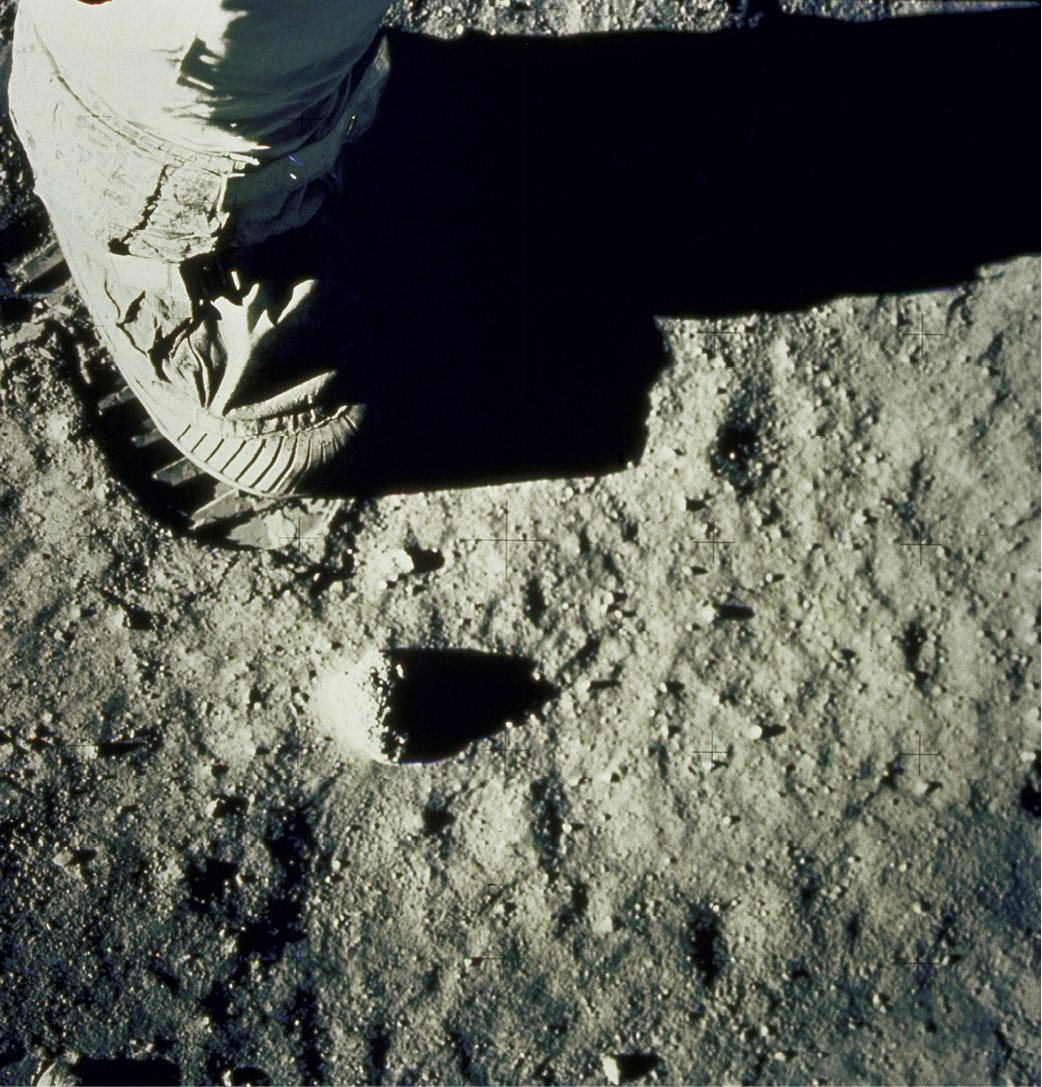
NASA
He said we should go to the moon before the decade was out, and we did (above: Buzz Aldrin’s boot touching down, after Neil Armstrong’s already has, on July 20, 1969).
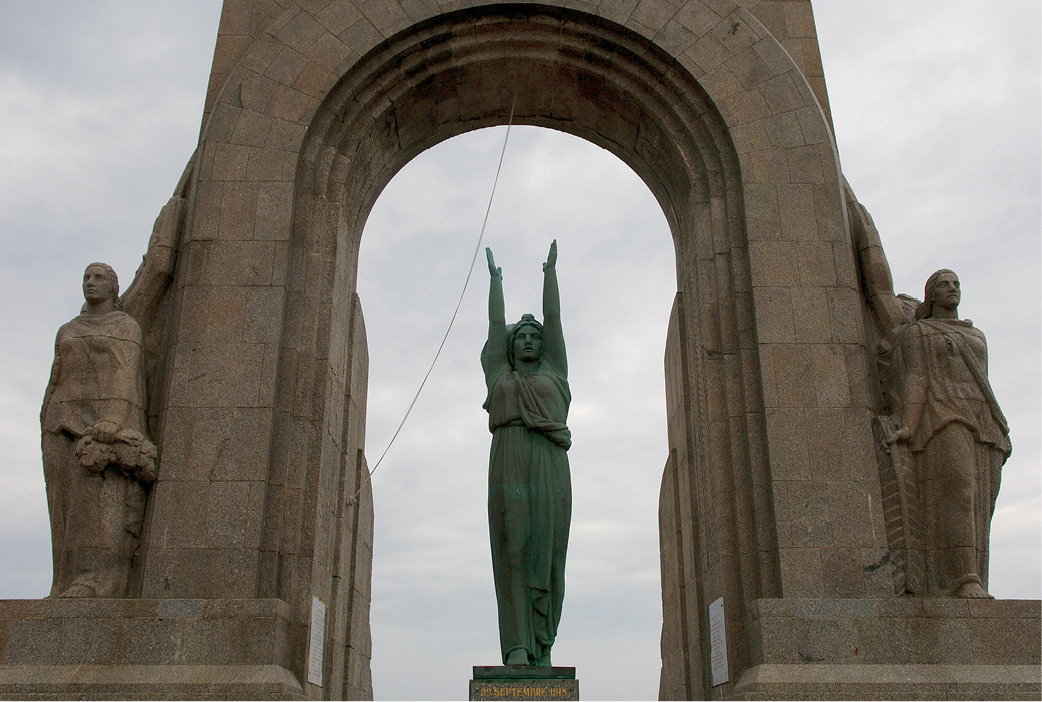
CHARLIE GRAY/CAMERA PRESS/REDUX
He said we should engage with the rest of the world in the postwar era—that the United States now had to assume such a leadership role—and we did (above: The John F. Kennedy Memorial to the Dead in the Orient, a tribute to French and Algerian soldiers, in Marseille, France).

PAOLO PELLEGRIN/MAGNUM
He said we should ask not for favors, but should ask how we might contribute to the greater societal good. He said much that will live down the decades and even centuries, and then he was cut down—in his prime, as they say. That was 50 years ago.
Today, he rests in peace in Arlington National Cemetery, where the plaque on his grave is simple and stark.
As this anniversary of his death confirms for us all: He will never be forgotten.